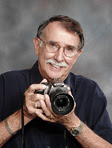In the Photoshop Elements SIG this month and in the following months we'll be going through exercises from the book "Adobe Photoshop Elements 8 Unleash the hidden performance of Elements" by Mark Galer and published by Focal Press. The book comes with a DVD with the images used in the book so as to follow along with the various lessons and movie tutorials that help following the text. It also comes with various actions and presets that can be downloaded to make the editing easier and better. This books can be obtained from Amazon for $29.67.
We started by pointing out the tutorials available for Elements users on photoshop.com. You also get 2 GB of online storage.All Elements registered users get access to photoshop.com from the Start-up screen. You first have to create an account. Plus accounts offer 20 GB of storage with additional tutorials other stuff. The cost is $49.99/year. At the SIG I played a video tutorial from the normal account "Creating a sense of movement". At the conclusion of the video we went through the tecniques described.
This month we covered book, Part 1 Project 4, Curves, Project 5 Hue/Saturation & Luminance and Project 6 Sharpening, Advanced Sharpening Techniques.
The Project 4 Curves described techniques in Elements that are similiar of the powrful Curves Adjustment in Photoshop for controlling contrast in an image. One of these was the use a Gradient Map Adjustment Layer in Luminosity mode.
I created a video of this technique and it can be viewed by clicking the link
http://tinyurl.com/2bhuf36
Advanced Sharpening Techniques will be shown in the next SIG in August. There will not be an Elements SIG in July.
I will show these steps shown for advanced sharpening techniques.
1. Open 1_P6_USM.tif
2. Dupe background layer by dragging to new layer icon
3. Filter > Other > High Pass
a. set the Radius to around 20 to 30 pixels for a 6 to 12 megapixel image.
b. Click OK
4. Apply the Despeckle filter - Filter > Noise > Despeckle
5. Next the Filter > Noise > Dust and Scratches –
a. R – 1
b. Threshold – 0
Note-the High Pass filter is sometimes used as an alternative to the Unsharp Mask if the duplicate layer is set to Overlay or Soft Light mode. In this project, however, we're using the High Pass filter to locate the edges within the image only.
6. Filter > Adjustments > Threshold is next applied - the threshold will reduce the slayer to 2 levels-black and white.
7. Drag the slider just below the histogram to isolate the edges that require sharpening. The aim of a moving of these sliders is to render all of those areas you do not want to sharpen white, or nearly white.
8. ClickOK
We're now halfway to creating a sharpening mask the mask will restrict the sharpening process to the edges only (the edges that we have just defined). Increasing or decreasing the radius in the High Pass filter will render the lines thicker or thinner.
9. Paint out any areas that were not rendered white by the Threshold adjustment that you don't want to be sharpened. In a portrait, any pixels remaining in the skin away from the eyes and mouth, nose and background is painted over using the brush tool with white selected as the foreground color.
10. Filter > Blur > Gaussian Blur
a.4 pixel radius to ensure the sharpening process will fade in slowly read it rather than have a sharp abrupt edge.
11. Magic Eraser Tool
a. Deselect the Contiguous option
12. Click on any white area within the image, and we should be left with only the edge detail on the layer and none of the white area.
13. duplicate the background layer and drag this duplicate layer to the top of the layer stack
14. Layer menu choose Create Clipping Mask or click on the dividing line between the two top layers with the Alt key depressed.
15. Enhanced > Unsharp Mask
a. Amount - 150
b. Radius - 0.8
c. Threshold - 5
16. Click OK
Wednesday, June 16, 2010
Subscribe to:
Post Comments (Atom)

1 comment:
Nice tutorial for me
https://freekeypro.com/proshow-gold-crack/
Post a Comment